Aerodynamic Design Optimization of Solar-Powered Vehicles using CFD
VerifiedAdded on 2022/12/30
|11
|2078
|92
AI Summary
This article discusses the aerodynamic design optimization of solar-powered vehicles using Computational Fluid Dynamics (CFD). It explores the significance of solar energy in the automotive industry and the potential of solar cars. The objectives and deliverables of the project are also outlined. The article provides a literature review on solar car racing and the aerodynamic drag of vehicles. It concludes with a discussion on automatic aerodynamic investigation methodologies using CFD.
Contribute Materials
Your contribution can guide someone’s learning journey. Share your
documents today.

C FD
By Name
Course
Instructor
Institution
Location
Date
Introduction
By Name
Course
Instructor
Institution
Location
Date
Introduction
Secure Best Marks with AI Grader
Need help grading? Try our AI Grader for instant feedback on your assignments.
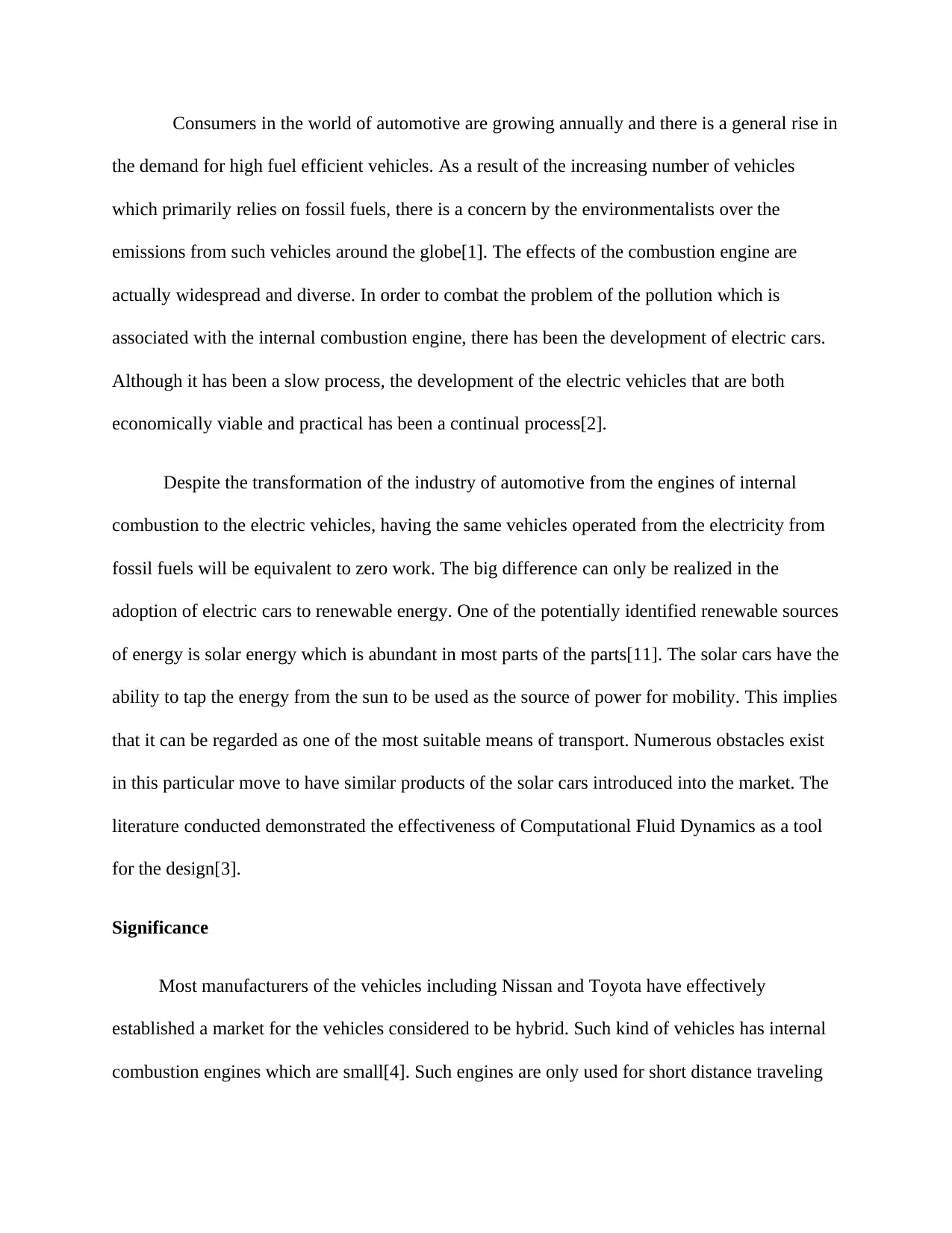
Consumers in the world of automotive are growing annually and there is a general rise in
the demand for high fuel efficient vehicles. As a result of the increasing number of vehicles
which primarily relies on fossil fuels, there is a concern by the environmentalists over the
emissions from such vehicles around the globe[1]. The effects of the combustion engine are
actually widespread and diverse. In order to combat the problem of the pollution which is
associated with the internal combustion engine, there has been the development of electric cars.
Although it has been a slow process, the development of the electric vehicles that are both
economically viable and practical has been a continual process[2].
Despite the transformation of the industry of automotive from the engines of internal
combustion to the electric vehicles, having the same vehicles operated from the electricity from
fossil fuels will be equivalent to zero work. The big difference can only be realized in the
adoption of electric cars to renewable energy. One of the potentially identified renewable sources
of energy is solar energy which is abundant in most parts of the parts[11]. The solar cars have the
ability to tap the energy from the sun to be used as the source of power for mobility. This implies
that it can be regarded as one of the most suitable means of transport. Numerous obstacles exist
in this particular move to have similar products of the solar cars introduced into the market. The
literature conducted demonstrated the effectiveness of Computational Fluid Dynamics as a tool
for the design[3].
Significance
Most manufacturers of the vehicles including Nissan and Toyota have effectively
established a market for the vehicles considered to be hybrid. Such kind of vehicles has internal
combustion engines which are small[4]. Such engines are only used for short distance traveling
the demand for high fuel efficient vehicles. As a result of the increasing number of vehicles
which primarily relies on fossil fuels, there is a concern by the environmentalists over the
emissions from such vehicles around the globe[1]. The effects of the combustion engine are
actually widespread and diverse. In order to combat the problem of the pollution which is
associated with the internal combustion engine, there has been the development of electric cars.
Although it has been a slow process, the development of the electric vehicles that are both
economically viable and practical has been a continual process[2].
Despite the transformation of the industry of automotive from the engines of internal
combustion to the electric vehicles, having the same vehicles operated from the electricity from
fossil fuels will be equivalent to zero work. The big difference can only be realized in the
adoption of electric cars to renewable energy. One of the potentially identified renewable sources
of energy is solar energy which is abundant in most parts of the parts[11]. The solar cars have the
ability to tap the energy from the sun to be used as the source of power for mobility. This implies
that it can be regarded as one of the most suitable means of transport. Numerous obstacles exist
in this particular move to have similar products of the solar cars introduced into the market. The
literature conducted demonstrated the effectiveness of Computational Fluid Dynamics as a tool
for the design[3].
Significance
Most manufacturers of the vehicles including Nissan and Toyota have effectively
established a market for the vehicles considered to be hybrid. Such kind of vehicles has internal
combustion engines which are small[4]. Such engines are only used for short distance traveling
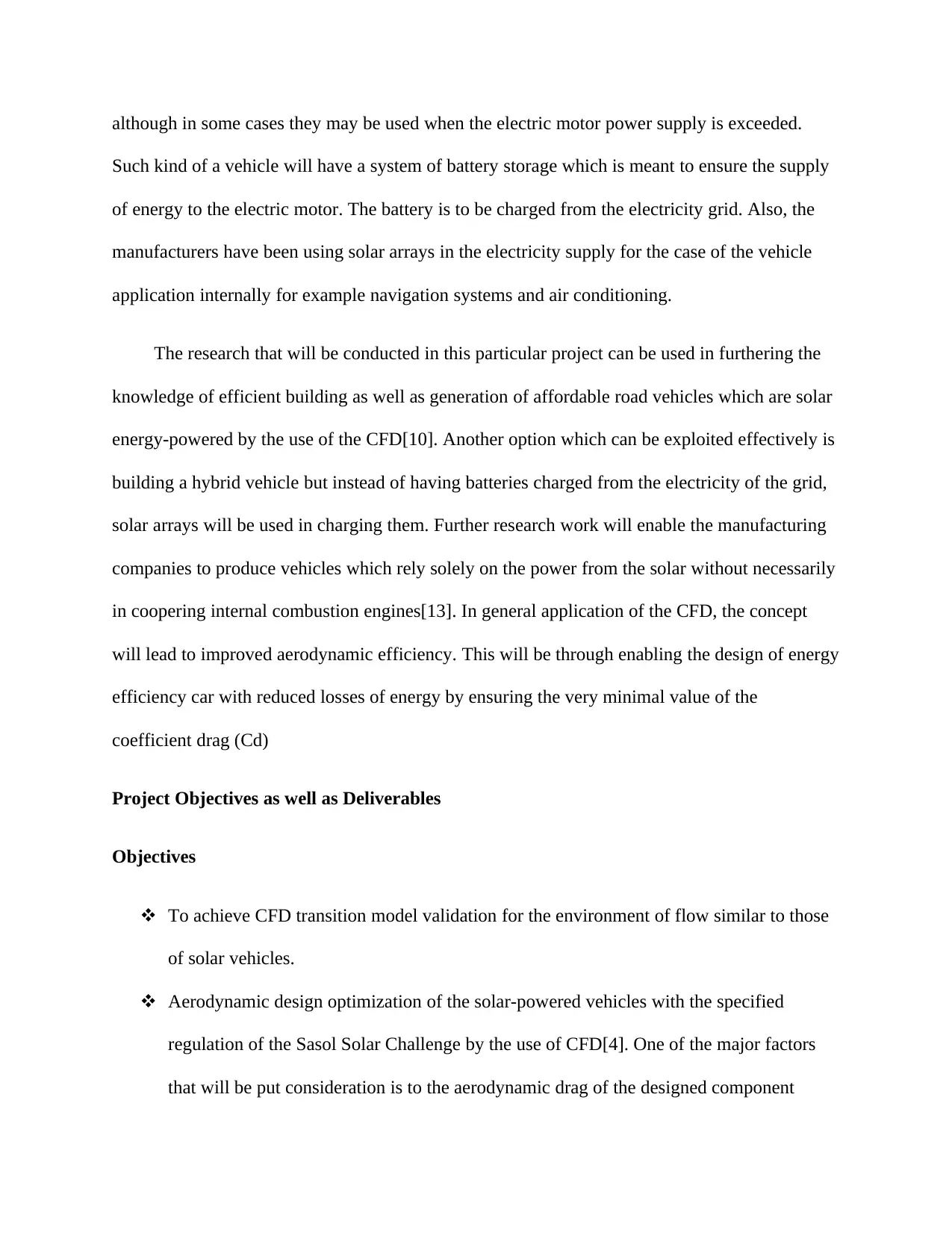
although in some cases they may be used when the electric motor power supply is exceeded.
Such kind of a vehicle will have a system of battery storage which is meant to ensure the supply
of energy to the electric motor. The battery is to be charged from the electricity grid. Also, the
manufacturers have been using solar arrays in the electricity supply for the case of the vehicle
application internally for example navigation systems and air conditioning.
The research that will be conducted in this particular project can be used in furthering the
knowledge of efficient building as well as generation of affordable road vehicles which are solar
energy-powered by the use of the CFD[10]. Another option which can be exploited effectively is
building a hybrid vehicle but instead of having batteries charged from the electricity of the grid,
solar arrays will be used in charging them. Further research work will enable the manufacturing
companies to produce vehicles which rely solely on the power from the solar without necessarily
in coopering internal combustion engines[13]. In general application of the CFD, the concept
will lead to improved aerodynamic efficiency. This will be through enabling the design of energy
efficiency car with reduced losses of energy by ensuring the very minimal value of the
coefficient drag (Cd)
Project Objectives as well as Deliverables
Objectives
To achieve CFD transition model validation for the environment of flow similar to those
of solar vehicles.
Aerodynamic design optimization of the solar-powered vehicles with the specified
regulation of the Sasol Solar Challenge by the use of CFD[4]. One of the major factors
that will be put consideration is to the aerodynamic drag of the designed component
Such kind of a vehicle will have a system of battery storage which is meant to ensure the supply
of energy to the electric motor. The battery is to be charged from the electricity grid. Also, the
manufacturers have been using solar arrays in the electricity supply for the case of the vehicle
application internally for example navigation systems and air conditioning.
The research that will be conducted in this particular project can be used in furthering the
knowledge of efficient building as well as generation of affordable road vehicles which are solar
energy-powered by the use of the CFD[10]. Another option which can be exploited effectively is
building a hybrid vehicle but instead of having batteries charged from the electricity of the grid,
solar arrays will be used in charging them. Further research work will enable the manufacturing
companies to produce vehicles which rely solely on the power from the solar without necessarily
in coopering internal combustion engines[13]. In general application of the CFD, the concept
will lead to improved aerodynamic efficiency. This will be through enabling the design of energy
efficiency car with reduced losses of energy by ensuring the very minimal value of the
coefficient drag (Cd)
Project Objectives as well as Deliverables
Objectives
To achieve CFD transition model validation for the environment of flow similar to those
of solar vehicles.
Aerodynamic design optimization of the solar-powered vehicles with the specified
regulation of the Sasol Solar Challenge by the use of CFD[4]. One of the major factors
that will be put consideration is to the aerodynamic drag of the designed component
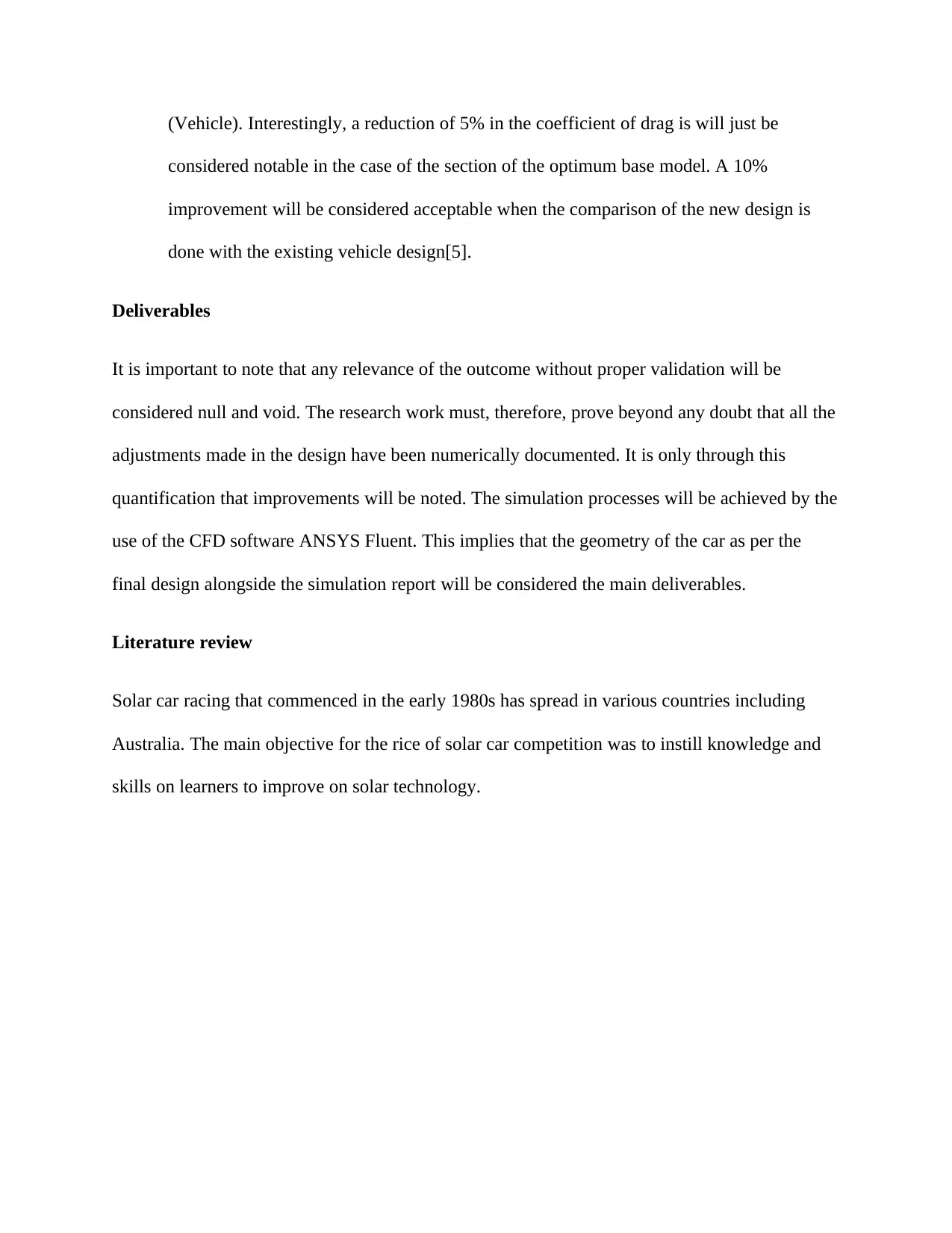
(Vehicle). Interestingly, a reduction of 5% in the coefficient of drag is will just be
considered notable in the case of the section of the optimum base model. A 10%
improvement will be considered acceptable when the comparison of the new design is
done with the existing vehicle design[5].
Deliverables
It is important to note that any relevance of the outcome without proper validation will be
considered null and void. The research work must, therefore, prove beyond any doubt that all the
adjustments made in the design have been numerically documented. It is only through this
quantification that improvements will be noted. The simulation processes will be achieved by the
use of the CFD software ANSYS Fluent. This implies that the geometry of the car as per the
final design alongside the simulation report will be considered the main deliverables.
Literature review
Solar car racing that commenced in the early 1980s has spread in various countries including
Australia. The main objective for the rice of solar car competition was to instill knowledge and
skills on learners to improve on solar technology.
considered notable in the case of the section of the optimum base model. A 10%
improvement will be considered acceptable when the comparison of the new design is
done with the existing vehicle design[5].
Deliverables
It is important to note that any relevance of the outcome without proper validation will be
considered null and void. The research work must, therefore, prove beyond any doubt that all the
adjustments made in the design have been numerically documented. It is only through this
quantification that improvements will be noted. The simulation processes will be achieved by the
use of the CFD software ANSYS Fluent. This implies that the geometry of the car as per the
final design alongside the simulation report will be considered the main deliverables.
Literature review
Solar car racing that commenced in the early 1980s has spread in various countries including
Australia. The main objective for the rice of solar car competition was to instill knowledge and
skills on learners to improve on solar technology.
Secure Best Marks with AI Grader
Need help grading? Try our AI Grader for instant feedback on your assignments.
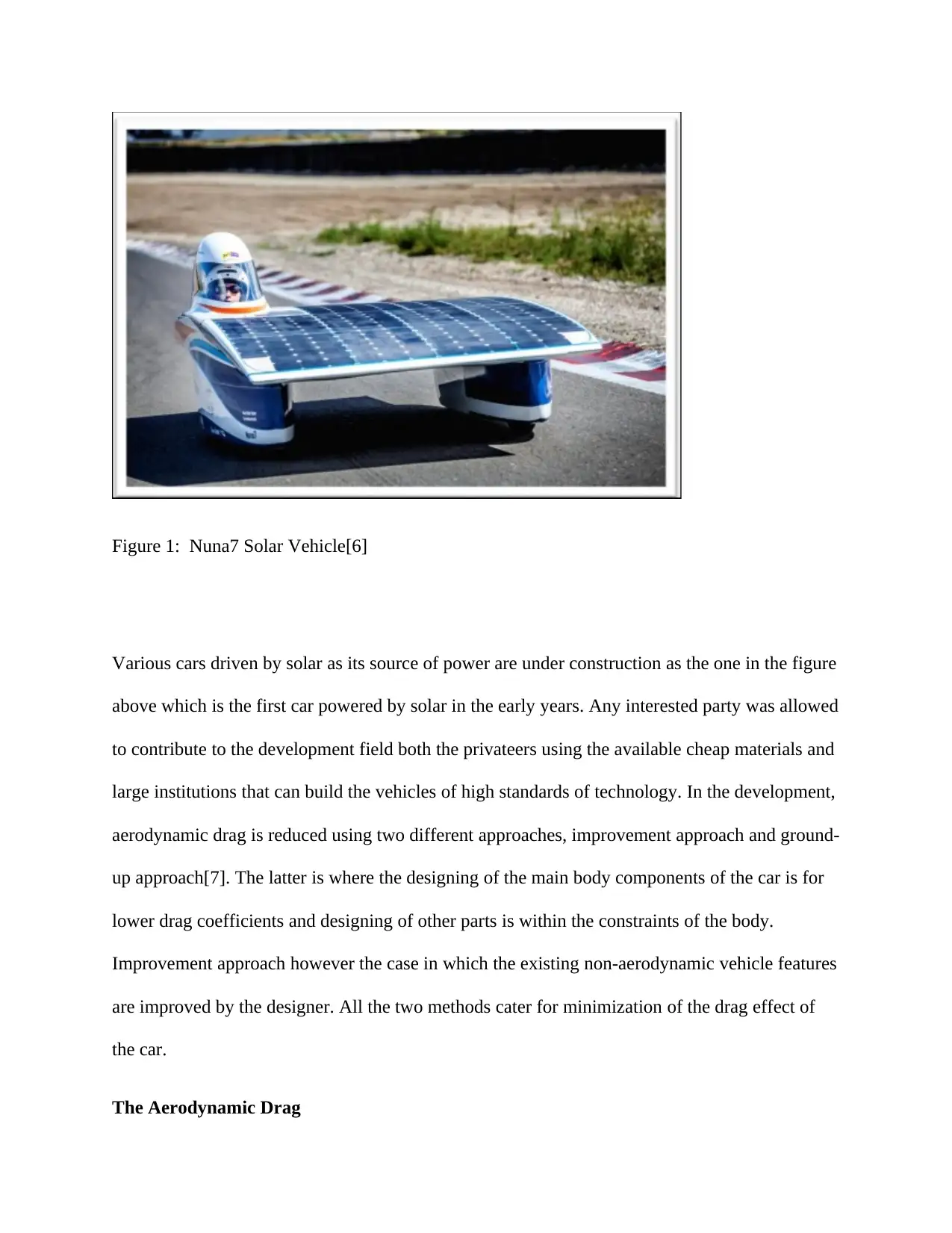
Figure 1: Nuna7 Solar Vehicle[6]
Various cars driven by solar as its source of power are under construction as the one in the figure
above which is the first car powered by solar in the early years. Any interested party was allowed
to contribute to the development field both the privateers using the available cheap materials and
large institutions that can build the vehicles of high standards of technology. In the development,
aerodynamic drag is reduced using two different approaches, improvement approach and ground-
up approach[7]. The latter is where the designing of the main body components of the car is for
lower drag coefficients and designing of other parts is within the constraints of the body.
Improvement approach however the case in which the existing non-aerodynamic vehicle features
are improved by the designer. All the two methods cater for minimization of the drag effect of
the car.
The Aerodynamic Drag
Various cars driven by solar as its source of power are under construction as the one in the figure
above which is the first car powered by solar in the early years. Any interested party was allowed
to contribute to the development field both the privateers using the available cheap materials and
large institutions that can build the vehicles of high standards of technology. In the development,
aerodynamic drag is reduced using two different approaches, improvement approach and ground-
up approach[7]. The latter is where the designing of the main body components of the car is for
lower drag coefficients and designing of other parts is within the constraints of the body.
Improvement approach however the case in which the existing non-aerodynamic vehicle features
are improved by the designer. All the two methods cater for minimization of the drag effect of
the car.
The Aerodynamic Drag
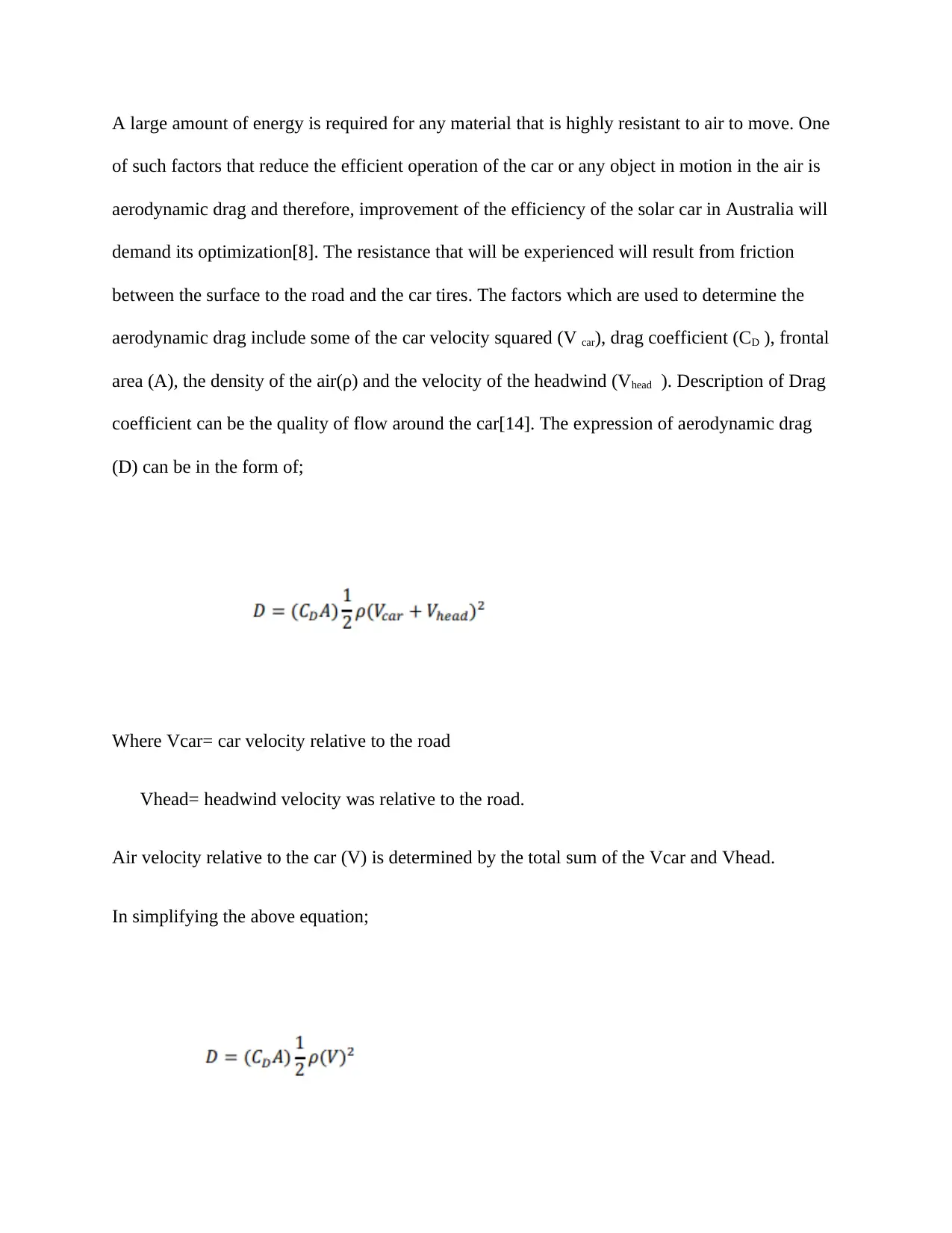
A large amount of energy is required for any material that is highly resistant to air to move. One
of such factors that reduce the efficient operation of the car or any object in motion in the air is
aerodynamic drag and therefore, improvement of the efficiency of the solar car in Australia will
demand its optimization[8]. The resistance that will be experienced will result from friction
between the surface to the road and the car tires. The factors which are used to determine the
aerodynamic drag include some of the car velocity squared (V car), drag coefficient (CD ), frontal
area (A), the density of the air(ρ) and the velocity of the headwind (Vhead ). Description of Drag
coefficient can be the quality of flow around the car[14]. The expression of aerodynamic drag
(D) can be in the form of;
Where Vcar= car velocity relative to the road
Vhead= headwind velocity was relative to the road.
Air velocity relative to the car (V) is determined by the total sum of the Vcar and Vhead.
In simplifying the above equation;
of such factors that reduce the efficient operation of the car or any object in motion in the air is
aerodynamic drag and therefore, improvement of the efficiency of the solar car in Australia will
demand its optimization[8]. The resistance that will be experienced will result from friction
between the surface to the road and the car tires. The factors which are used to determine the
aerodynamic drag include some of the car velocity squared (V car), drag coefficient (CD ), frontal
area (A), the density of the air(ρ) and the velocity of the headwind (Vhead ). Description of Drag
coefficient can be the quality of flow around the car[14]. The expression of aerodynamic drag
(D) can be in the form of;
Where Vcar= car velocity relative to the road
Vhead= headwind velocity was relative to the road.
Air velocity relative to the car (V) is determined by the total sum of the Vcar and Vhead.
In simplifying the above equation;
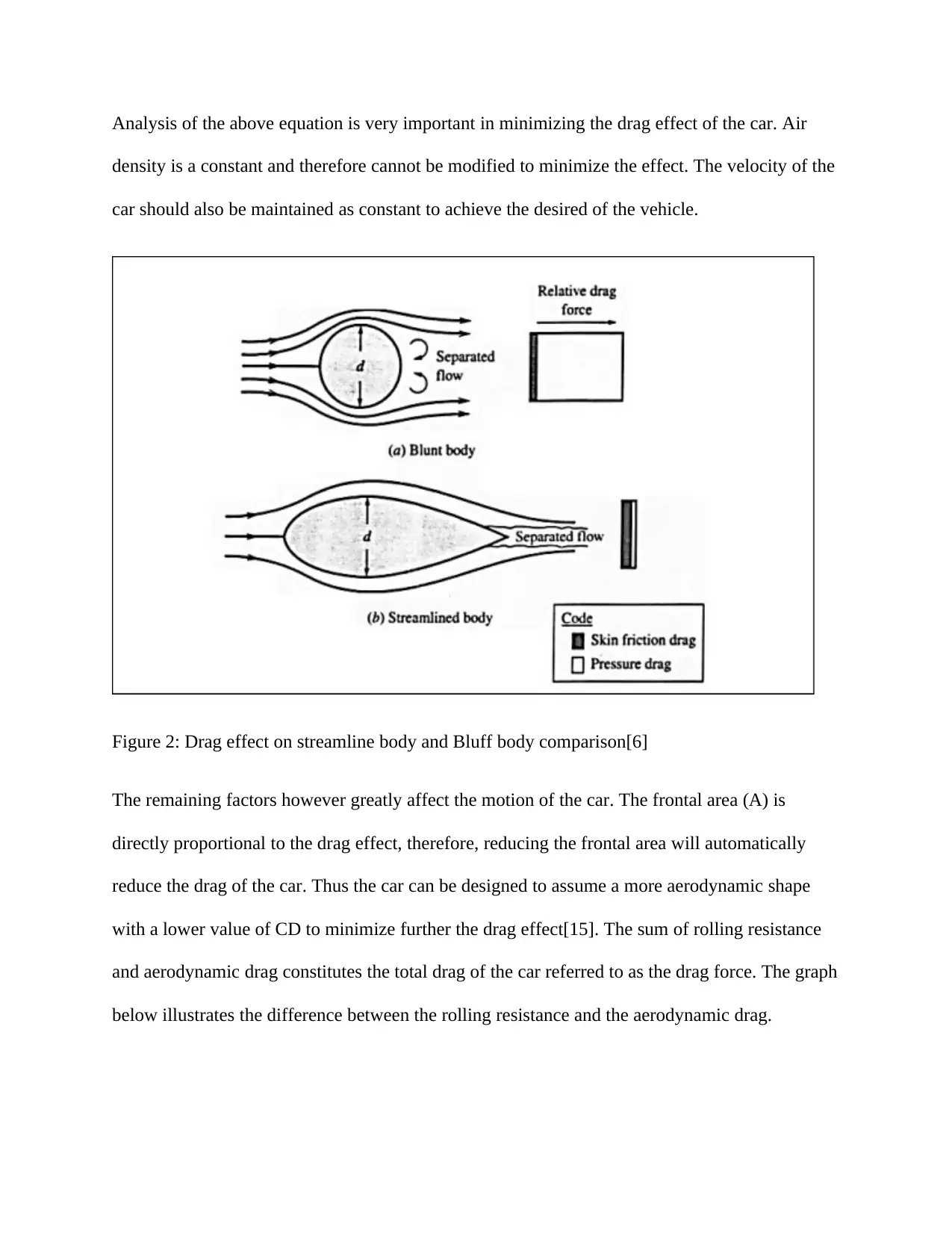
Analysis of the above equation is very important in minimizing the drag effect of the car. Air
density is a constant and therefore cannot be modified to minimize the effect. The velocity of the
car should also be maintained as constant to achieve the desired of the vehicle.
Figure 2: Drag effect on streamline body and Bluff body comparison[6]
The remaining factors however greatly affect the motion of the car. The frontal area (A) is
directly proportional to the drag effect, therefore, reducing the frontal area will automatically
reduce the drag of the car. Thus the car can be designed to assume a more aerodynamic shape
with a lower value of CD to minimize further the drag effect[15]. The sum of rolling resistance
and aerodynamic drag constitutes the total drag of the car referred to as the drag force. The graph
below illustrates the difference between the rolling resistance and the aerodynamic drag.
density is a constant and therefore cannot be modified to minimize the effect. The velocity of the
car should also be maintained as constant to achieve the desired of the vehicle.
Figure 2: Drag effect on streamline body and Bluff body comparison[6]
The remaining factors however greatly affect the motion of the car. The frontal area (A) is
directly proportional to the drag effect, therefore, reducing the frontal area will automatically
reduce the drag of the car. Thus the car can be designed to assume a more aerodynamic shape
with a lower value of CD to minimize further the drag effect[15]. The sum of rolling resistance
and aerodynamic drag constitutes the total drag of the car referred to as the drag force. The graph
below illustrates the difference between the rolling resistance and the aerodynamic drag.
Paraphrase This Document
Need a fresh take? Get an instant paraphrase of this document with our AI Paraphraser
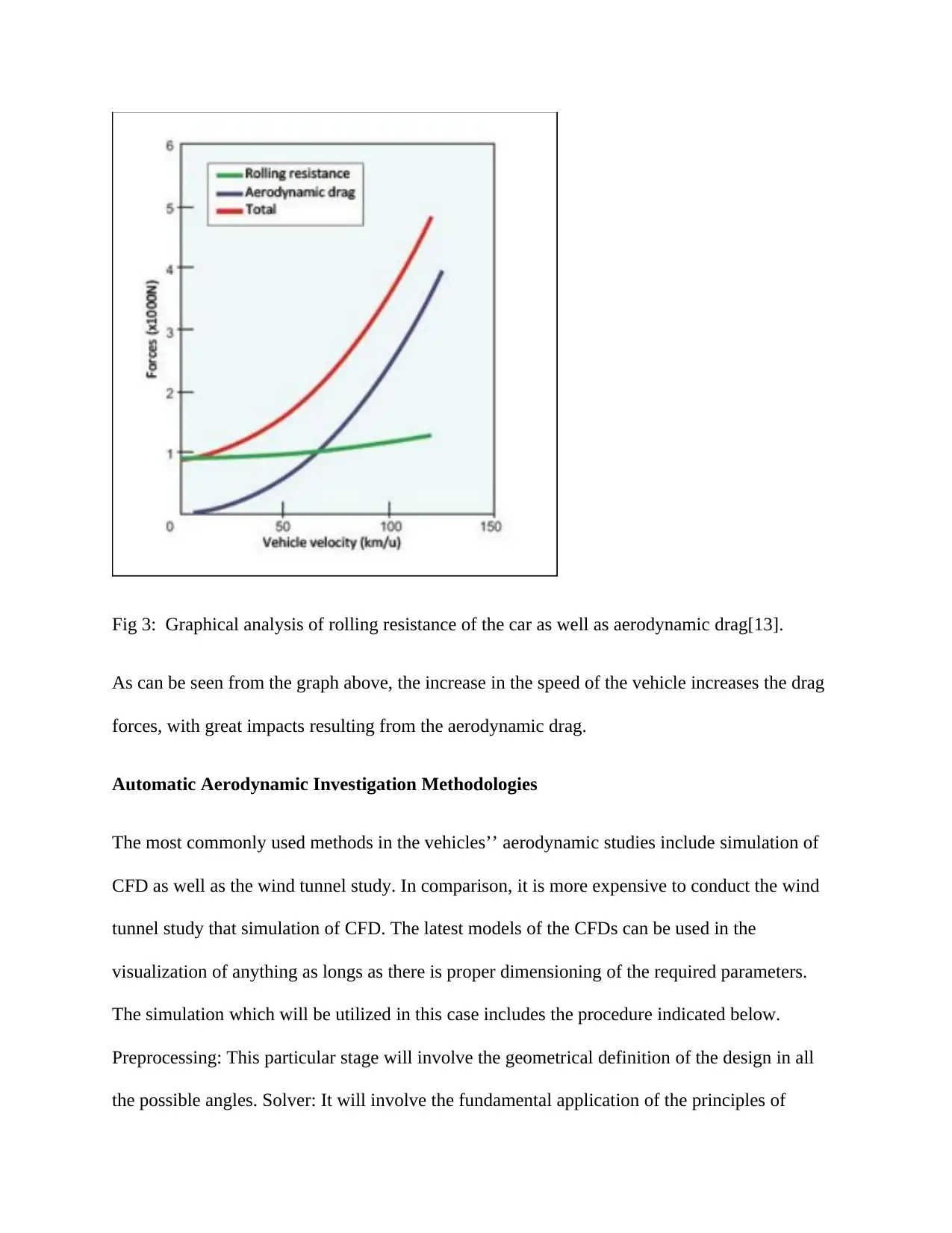
Fig 3: Graphical analysis of rolling resistance of the car as well as aerodynamic drag[13].
As can be seen from the graph above, the increase in the speed of the vehicle increases the drag
forces, with great impacts resulting from the aerodynamic drag.
Automatic Aerodynamic Investigation Methodologies
The most commonly used methods in the vehicles’’ aerodynamic studies include simulation of
CFD as well as the wind tunnel study. In comparison, it is more expensive to conduct the wind
tunnel study that simulation of CFD. The latest models of the CFDs can be used in the
visualization of anything as longs as there is proper dimensioning of the required parameters.
The simulation which will be utilized in this case includes the procedure indicated below.
Preprocessing: This particular stage will involve the geometrical definition of the design in all
the possible angles. Solver: It will involve the fundamental application of the principles of
As can be seen from the graph above, the increase in the speed of the vehicle increases the drag
forces, with great impacts resulting from the aerodynamic drag.
Automatic Aerodynamic Investigation Methodologies
The most commonly used methods in the vehicles’’ aerodynamic studies include simulation of
CFD as well as the wind tunnel study. In comparison, it is more expensive to conduct the wind
tunnel study that simulation of CFD. The latest models of the CFDs can be used in the
visualization of anything as longs as there is proper dimensioning of the required parameters.
The simulation which will be utilized in this case includes the procedure indicated below.
Preprocessing: This particular stage will involve the geometrical definition of the design in all
the possible angles. Solver: It will involve the fundamental application of the principles of

science and formula[7]. Some of the principles will include the properties of the fluids, boundary
layer conditions and the Bernoulli's principle of flow in physics. Post Processing: It involves an
analysis of the final results. Various method of data representation including the use of graphs,
data curves, plots among others is used here. The proposed project thus seeks to use this
particular tool for the CFD analysis[12].
layer conditions and the Bernoulli's principle of flow in physics. Post Processing: It involves an
analysis of the final results. Various method of data representation including the use of graphs,
data curves, plots among others is used here. The proposed project thus seeks to use this
particular tool for the CFD analysis[12].
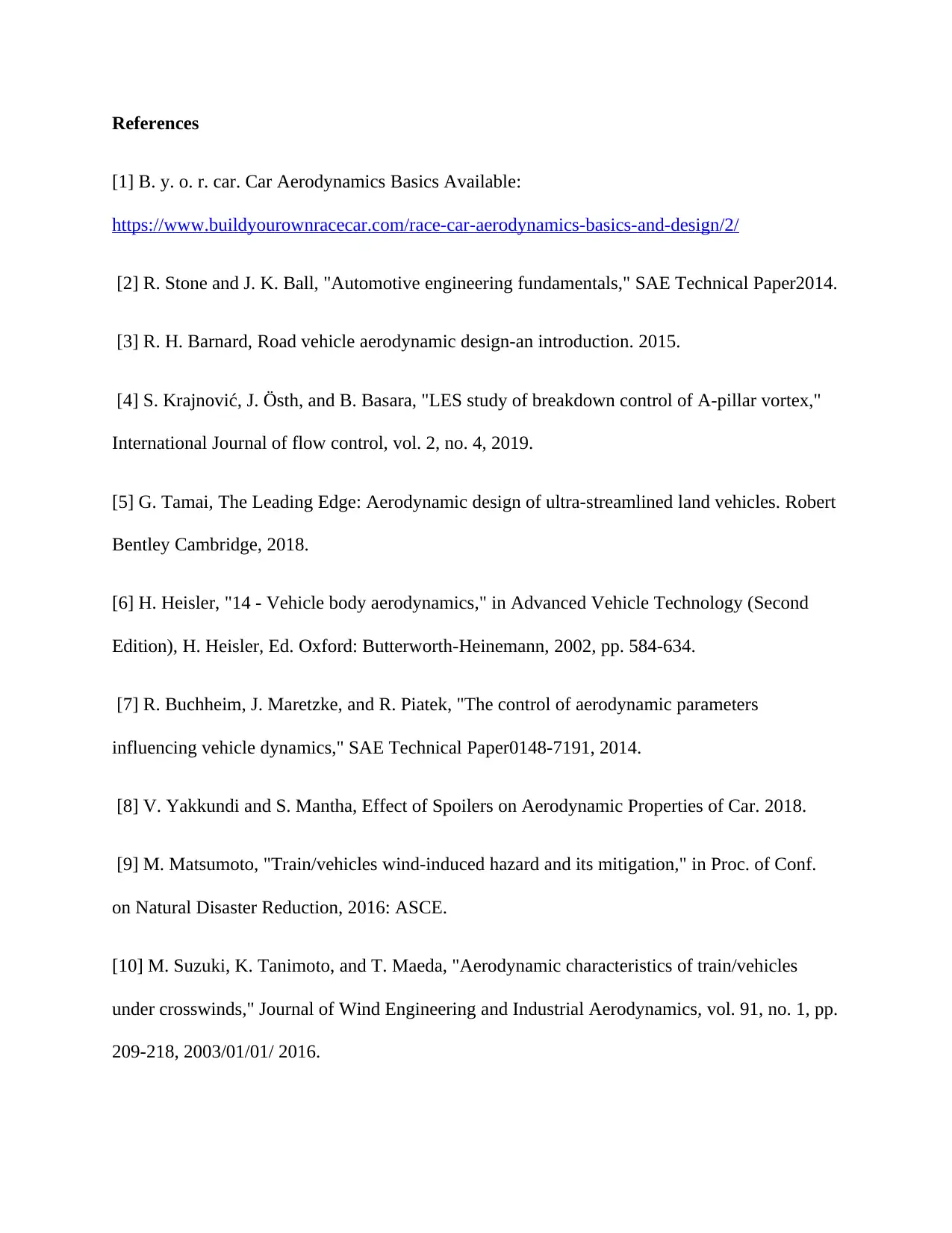
References
[1] B. y. o. r. car. Car Aerodynamics Basics Available:
https://www.buildyourownracecar.com/race-car-aerodynamics-basics-and-design/2/
[2] R. Stone and J. K. Ball, "Automotive engineering fundamentals," SAE Technical Paper2014.
[3] R. H. Barnard, Road vehicle aerodynamic design-an introduction. 2015.
[4] S. Krajnović, J. Östh, and B. Basara, "LES study of breakdown control of A-pillar vortex,"
International Journal of flow control, vol. 2, no. 4, 2019.
[5] G. Tamai, The Leading Edge: Aerodynamic design of ultra-streamlined land vehicles. Robert
Bentley Cambridge, 2018.
[6] H. Heisler, "14 - Vehicle body aerodynamics," in Advanced Vehicle Technology (Second
Edition), H. Heisler, Ed. Oxford: Butterworth-Heinemann, 2002, pp. 584-634.
[7] R. Buchheim, J. Maretzke, and R. Piatek, "The control of aerodynamic parameters
influencing vehicle dynamics," SAE Technical Paper0148-7191, 2014.
[8] V. Yakkundi and S. Mantha, Effect of Spoilers on Aerodynamic Properties of Car. 2018.
[9] M. Matsumoto, "Train/vehicles wind-induced hazard and its mitigation," in Proc. of Conf.
on Natural Disaster Reduction, 2016: ASCE.
[10] M. Suzuki, K. Tanimoto, and T. Maeda, "Aerodynamic characteristics of train/vehicles
under crosswinds," Journal of Wind Engineering and Industrial Aerodynamics, vol. 91, no. 1, pp.
209-218, 2003/01/01/ 2016.
[1] B. y. o. r. car. Car Aerodynamics Basics Available:
https://www.buildyourownracecar.com/race-car-aerodynamics-basics-and-design/2/
[2] R. Stone and J. K. Ball, "Automotive engineering fundamentals," SAE Technical Paper2014.
[3] R. H. Barnard, Road vehicle aerodynamic design-an introduction. 2015.
[4] S. Krajnović, J. Östh, and B. Basara, "LES study of breakdown control of A-pillar vortex,"
International Journal of flow control, vol. 2, no. 4, 2019.
[5] G. Tamai, The Leading Edge: Aerodynamic design of ultra-streamlined land vehicles. Robert
Bentley Cambridge, 2018.
[6] H. Heisler, "14 - Vehicle body aerodynamics," in Advanced Vehicle Technology (Second
Edition), H. Heisler, Ed. Oxford: Butterworth-Heinemann, 2002, pp. 584-634.
[7] R. Buchheim, J. Maretzke, and R. Piatek, "The control of aerodynamic parameters
influencing vehicle dynamics," SAE Technical Paper0148-7191, 2014.
[8] V. Yakkundi and S. Mantha, Effect of Spoilers on Aerodynamic Properties of Car. 2018.
[9] M. Matsumoto, "Train/vehicles wind-induced hazard and its mitigation," in Proc. of Conf.
on Natural Disaster Reduction, 2016: ASCE.
[10] M. Suzuki, K. Tanimoto, and T. Maeda, "Aerodynamic characteristics of train/vehicles
under crosswinds," Journal of Wind Engineering and Industrial Aerodynamics, vol. 91, no. 1, pp.
209-218, 2003/01/01/ 2016.
Secure Best Marks with AI Grader
Need help grading? Try our AI Grader for instant feedback on your assignments.

[11] W. S. C. 2019. (2019). 2019 Regulations. Available:
https://www.worldsolarchallenge.org/event-information/2019_regulations
[12] Z. Lyu, "Aerodynamic Wind Tunnel in Passenger Car Application," Independent thesis
Advanced level (degree of Master (Two Years)) Student thesis, 2016.
[13] D. Damjanović, D. Kozak, M. Živić, Ž. Ivandić, and T. Baškarić, "CFD analysis of concept
car in order to improve aerodynamics," Járműipari innováció, vol. 1, no. 2, pp. 108-115, 2017
[14] C. UK, "DriveAer," in DriveAer Automotive Workshop, 2016.
[15] T. Frank, B. Gerlicher, and J. Abanto, DrivAer-Aerodynamic Investigations for a New
Realistic Generic Car Model using ANSYS CFD. 2018
https://www.worldsolarchallenge.org/event-information/2019_regulations
[12] Z. Lyu, "Aerodynamic Wind Tunnel in Passenger Car Application," Independent thesis
Advanced level (degree of Master (Two Years)) Student thesis, 2016.
[13] D. Damjanović, D. Kozak, M. Živić, Ž. Ivandić, and T. Baškarić, "CFD analysis of concept
car in order to improve aerodynamics," Járműipari innováció, vol. 1, no. 2, pp. 108-115, 2017
[14] C. UK, "DriveAer," in DriveAer Automotive Workshop, 2016.
[15] T. Frank, B. Gerlicher, and J. Abanto, DrivAer-Aerodynamic Investigations for a New
Realistic Generic Car Model using ANSYS CFD. 2018
1 out of 11
Related Documents
Your All-in-One AI-Powered Toolkit for Academic Success.
+13062052269
info@desklib.com
Available 24*7 on WhatsApp / Email
![[object Object]](/_next/static/media/star-bottom.7253800d.svg)
Unlock your academic potential
© 2024 | Zucol Services PVT LTD | All rights reserved.





